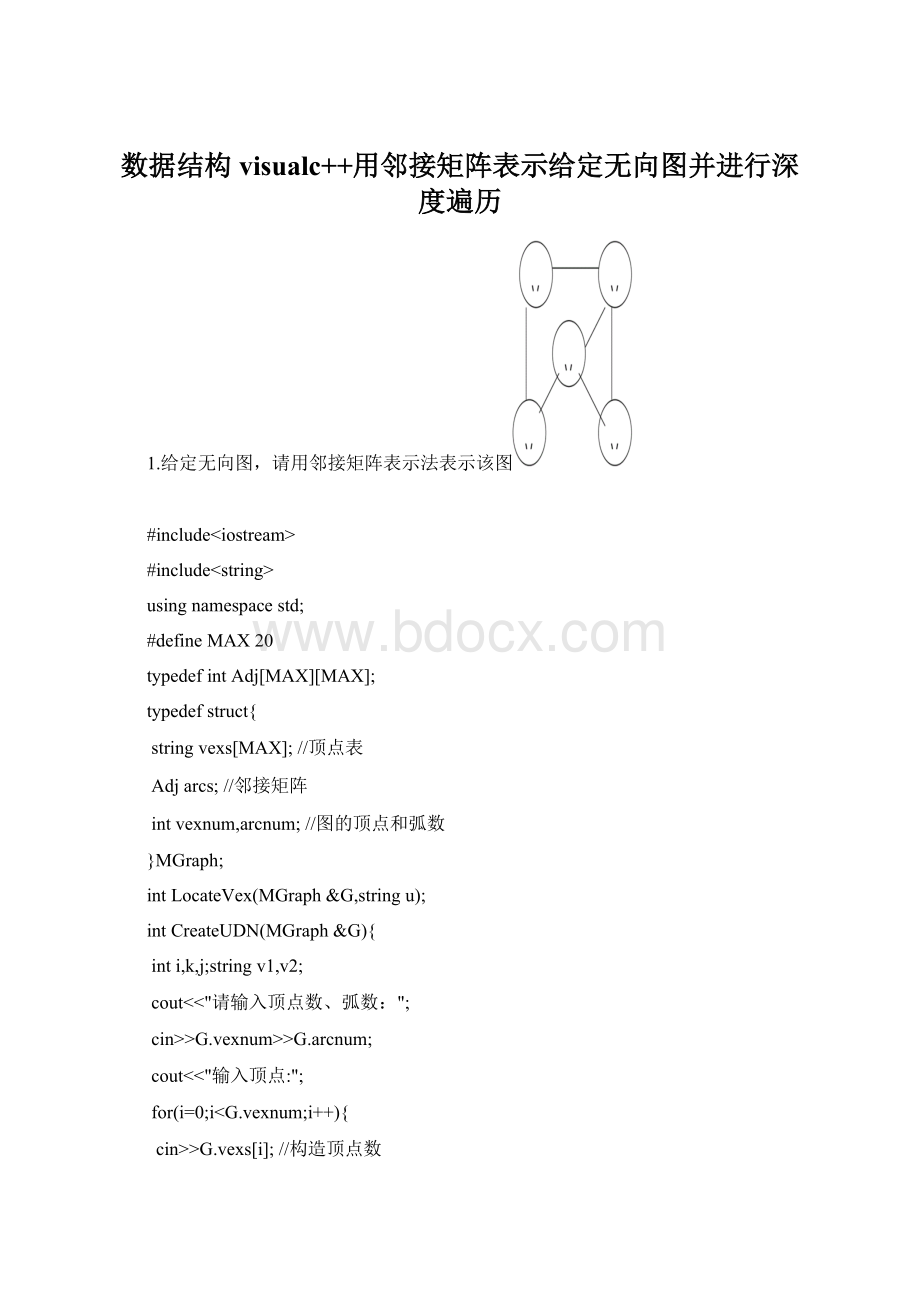数据结构visualc++用邻接矩阵表示给定无向图并进行深度遍历Word下载.docx
《数据结构visualc++用邻接矩阵表示给定无向图并进行深度遍历Word下载.docx》由会员分享,可在线阅读,更多相关《数据结构visualc++用邻接矩阵表示给定无向图并进行深度遍历Word下载.docx(20页珍藏版)》请在冰豆网上搜索。

}
for(k=0;
k<
k++){
cout<
输入第"
k+1<
边依附的两个顶点:
v1>
v2;
i=LocateVex(G,v1);
j=LocateVex(G,v2);
G.arcs[i][j]=1;
G.arcs[j][i]=1;
//置<
v1,v2>
的对称弧<
v2,v1>
return0;
}
G,stringu){//确定u在G中序号
inti;
for(i=0;
i++){
if(u==G.vexs[i])
returni;
if(i==G.vexnum){
Erroru!
endl;
exit
(1);
voidShowG(MGraph&
G){
inti,j;
G.vexs[i]<
"
cout<
G.arcs[i][j]<
main(){
MGraphA;
inta;
a=CreateUDN(A);
ShowG(A);
2.分别使用邻接矩阵表示法和邻接表表示法,用深度优先搜索法遍历该图。
#include<
string.h>
malloc.h>
conio.h>
intvisited[30];
#defineMAX_VERTEX_NUM30
#defineOK1
//typedefintVertexType;
typedefintInfoType;
typedefstructArcNode//弧
{
intadjvex;
structArcNode*nextarc;
}ArcNode;
typedefstructVNode//表头
intdata;
ArcNode*firstarc;
}VNode,AdjList[MAX_VERTEX_NUM];
typedefstruct//图
{
AdjListvertices;
intkind;
}ALGraph;
voidCreateDG(ALGraph&
G)
intk,i,v1;
endl<
请输入结点个数:
请输入弧的个数:
for(i=1;
=G.vexnum;
i++)//初使化表头
{
G.vertices[i].data=i;
G.vertices[i].firstarc=NULL;
for(k=1;
k++)//输入边
intv2;
请输入与结点"
相邻的边数:
请输入与第"
个结点相连的结点编号:
v1;
ArcNode*p;
p=(ArcNode*)malloc(sizeof(ArcNode));
if(!
p)exit(-1);
p->
adjvex=v1;
nextarc=NULL;
G.vertices[k].firstarc=p;
for(inti=1;
i++)
{
intm;
m;
ArcNode*q;
q=(ArcNode*)malloc(sizeof(ArcNode));
//动态指针
q)exit(-1);
q->
adjvex=m;
//顶点给P
nextarc=q;
p=q;
//free(q);
//free(p);
}
}
voidDFS(ALGraphG,intv)//深度搜索
visited[v]=1;
G.vertices[v].data<
ArcNode*x;
x=(ArcNode*)malloc(sizeof(ArcNode));
x)exit(-1);
x=G.vertices[v].firstarc;
intw;
for(;
x;
x=x->
nextarc)
{w=x->
adjvex;
if(visited[w]==0)
DFS(G,w);
voidDFSB(ALGraphG,intv)//深度搜索的边集
ArcNode*y;
y=(ArcNode*)malloc(sizeof(ArcNode));
y)exit(-1);
y=G.vertices[v].firstarc;
intu=G.vertices[v].data;
for(;
y;
y=y->
{w=y->
u<
--->
w<
DFSB(G,w);
typedefstructQNode
QNode*next;
}QNode,*QueuePtr;
typedefstruct
QueuePtrfront;
QueuePtrrear;
}LinkQueue;
voidInitQueue(LinkQueue&
Q)//建立一个空队列
Q.front=Q.rear=(QueuePtr)malloc(sizeof(QNode));
Q.front)exit(-1);
Q.front->
next=NULL;
voidEnQueue(LinkQueue&
Q,inte)//进队
QNode*p;
p=(QNode*)malloc(sizeof(QNode));
data=e;
Q.rear->
next=p;
Q.rear=p;
intDeQueue(LinkQueue&
Q,int&
e)//出队
if(Q.front==Q.rear)
return-1;
p=Q.front->
next;
e=p->
data;
next=p->
if(Q.rear==p)
Q.rear=Q.front;
free(p);
returne;
intQueueEmpty(LinkQueueQ)//判断队列是否为空
return1;
voidBFS(ALGraphG,intv)//广度搜索
intu;
LinkQueueQ;
InitQueue(Q);
if(visited[v]==0)
EnQueue(Q,v);
while(QueueEmpty(Q)!
=1)
DeQueue(Q,u);
ArcNode*z;
z=(ArcNode*)malloc(sizeof(ArcNode));
z)exit(-1);
z=G.vertices[u].firstarc;
/*
for(intw=z->
w>
=0;
w=z->
nextarc->
adjvex)
visited[w]=1;
EnQueue(Q,w);
}*/
z;
z=z->
{w=z->
voidBFSB(ALGraphG,intv)//广度搜索的边集
ArcNode*r;
r=(ArcNode*)malloc(sizeof(ArcNode));
r)exit(-1);
r=G.vertices[u].firstarc;
r!
=NULL;
r=r->
{w=r->
intmain()
ALGraphG;
CreateDG(G);
intx;
请输入结点数:
邻接表为:
for(intj=1;
=x;
j++)
G.vertices[j].data<
p=G.vertices[j].firstarc;
while(p)
p->
adjvex<
p=p->
nextarc;
请输入第一个要访问的结点序号:
intn;
n;
for(i=0;
30;
visited[i]=0;
广度搜索:
BFS(G,n);
边集:
BFSB(G,n);
深度搜索:
DFS(G,n);
DFSB(G,n);
//system("
pause"
);
3.对学生选课工程图进行拓扑排序.
stdio.h>
stdlib.h>
#defineMAX_VEXTEX_NUM20
#defineM20
#defineSTACK_INIT_SIZE100
#defineSTACKINCREMENT10
#defineOK1
#defineERROR0
typedefintElemType;
typedefstructArcNode
intadjvex;
structArcNode*nextarc;
typedefstructVNode
intdata;
ArcNode*firstarc;
}VNode,AdjList[MAX_VEXTEX_NUM];
AdjListvertices;
intvexnum,arcnum;
typedefstruct//构件栈
ElemType*base;
ElemType*top;
intstacksize;
}SqStack;
voidInitStack(SqStack*);
//函数声明
intPop(SqStack*,ElemType*);
voidPush(SqStack*,ElemType);
intStackEmpty(SqStack*);
voidCreatGraph(ALGraph*);
voidFindInDegree(ALGraph,int*);
voidTopologicalSort(ALGraph);
voidInitStack(SqStack*S)//初始化栈
S->
base=(ElemType*)malloc(STACK_INIT_SIZE*sizeof(ElemType));
if(!
base)
printf("
memoryallocationfailed,goodbye"
exit
(1);
top=S->
base;
stacksize=STACK_INIT_SIZE;
intPop(SqStack*S,ElemType*e)//出栈操作
if(S->
top==S->
{returnERROR;
*e=*--S->
top;
//printf("
%d\n"
e);
//returne;
return0;
voidPush(SqStack*S,ElemTypee)//进栈操作
{if(S->
top-S->
base>
=S->
stacksize)
base=(ElemType*)realloc(S->
base,(S->
stacksize+STACKINCREMENT)*sizeof(ElemType));
top=S->
base+S->
stacksize;
stacksize+=STACKINCREMENT;
}*S->
top++=e;
intStackEmpty(SqStack*S)//判断栈是否为空
returnOK;
else
returnERROR;
voidCreatGraph(ALGraph*G)//构件图
{intm,n,i;
ArcNode*p;
请输入顶点数和边数:
scanf("
%d%d"
&
G->
vexnum,&
arcnum);
for(i=1;
i<
=G->
vexnum;
i++)
{G->
vertices[i].data=i;
vertices[i].firstarc=NULL;
arcnum;
i++)//输入存在边的点集合
\n请输入存在边的两个顶点的序号:
n,&
m);
while(n<
0||n>
G->
vexnum||m<
0||m>
vexnum)
{printf("
输入的顶点序号不正确请重新输入:
p=(ArcNode*)malloc(sizeof(ArcNode));
if(p==NULL)
memoryallocationfailed,goodbey"
adjvex=m;
nextarc=G->
vertices[n].firstarc;
vertices[n].firstarc=p;
建立的邻接表为:
\n"
//输出建立好的邻接表
for(i=1;
%d"
G->
vertices[i].data);
for(p=G->
vertices[i].firstarc;
p;
p=p->
%3d"
p->
adjvex);
}}
voidFindInDegree(ALGraphG,intindegree[])//求入度操作
inti;
=G.vexnum;
indegree[i]=0;
{while(G.vertices[i].firstarc)
{indegree[G.vertices[i].firstarc->
adjvex]++;
G.vertices[i].firstarc=G.vertices[i].firstarc->
voidTopologicalSort(ALGraphG)//进行拓扑排序
intindegree[M];
inti,k,n;
intcount=0;
SqStackS;
FindInDegree(G,indegree);
InitStack(&
S);
第%d个点的入度为%d\n"
i,indegree[i]);
for(i=1;
if(!
indegree[i])
Push(&
S,i);
进行拓扑排序输出顺序为:
//输出结果
while(!
StackEmpty(&
S))
Pop(&
S,&
n);
%4d"
G.vertices[n].data);
count++;
for(p=G.vertices[n].firstarc;
p!
=NULL;
k=p->
(--indegree[k]))
S,k);
}printf("
if(count<
G.vexnum)
出现错误\n"
排序成功\n"
intmain(void)//主函数
ALGraphG;
CreatGraph(&
G);
TopologicalSort(G);
system("